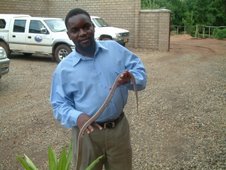
(this article appeared in the Sunday Times)
This adoption is not right
By HASTINGS MALOYA
Today, the one-year-old little known David Banda from Mchinji is spending his fifth day in his new home near London's Marble Arch in the United Kingdom at a start of his 18 months’ temporary custody by his new parents. And when all the legal requirements are made, this home shall never be temporal and from then, his mother will be no other than the internationally acclaimed pop star, Madonna.
Yes, David has been adopted by the queen of pop. It is said by some quarters that the child is out of the poverty circles and chances are high that he might have an enjoyable life. His father Yohane Banda was quote in the international press saying, "I am the father of David, who has been adopted. I am very very happy because as you can see there is poverty in this village and I know he will be very well looked after in America."
One could not be too sure whether David will go to America or will stay in Britain. Maybe the father was not told the exact destination. But the father, just as many commentators, was more exited that his child will be out of poverty. The issue has raised international media interest and locally the entire process through which it has been handled has brought up an interesting debate.
David, to be assisted and supported away from home? Not a good idea really.
When it was first reported in June, 2006 that Madonna will tour Malawi before the end of the year, surely many people were trying to imagine and figure out what type of a concert she would perform and at which venues. Of course it was mentioned that she was coming for charity towards the HIV/Aids pandemic. Fun seekers were meanwhile guessing how much it could cost to witness such a concert. For those that had an idea of her performances were not too sure if Malawi has any sort of arena for the Material Girl, as she is popularly known.
It was left to be seen once she is in the country.
Very few people, if any, were aware of the exact dates for the visiting Madonna. It therefore came as a surprise when she landed. There was no proper schedule nor itinerary released. Since journalists had problems to trace the pop queen, it was difficult to have a clear indications and objectives of the visit. The government also seemed to be in the dark. There was a lot of secrecy.
News had it that she was in Lilongwe before it was reported that she was at Bvumbwe in Thyolo and later she opened up to the press when she was in Mchinji. She was visiting orphanages. And after these visits, speculation that the singer was planning to adopt a child began. Through the BBC, Madonna's publicist Liz Rosenberg initially denied the adoption reports. But it was said that the 48-year-old Madonna had travelled to Malawi with her husband, film-maker Guy Ritchie, to help fight poverty and the problem of HIV and AIDS. A wonderful idea.
But later the rumour about adoption was becoming a reality. First it was a girl from Lilongwe that was in the papers claiming that she would be the one to join Madonna across the oceans. Later things changed and the name of David came in. What followed was a marathon of legal battles and protests. Nevertheless, the pop diva won and managed to get the child out of Malawi. Definitely there was much work done to have the baby’s passport and visa applied, approved and processed.
The biggest worry has been changes and inconsistence of statements especially from government officials.
Several TV news channels showed footages of a woman carrying the child through the Johannesburg airport with officials that acted as bodyguards. The TV pictures showed the baby with a grey-hooded top hiding him from the view of surrounding press. The secrecy remained. It still remains to be explained why such an action.
It is said that David’s mother Marita died a month after his birth from childbirth complications and that since then the child had been cared for at Orphan Care Centre. It could possibly be that he needed special attention being in the tender age. But surely the father is energetic enough and at some point he could be able to look after the boy. It is not very clear whether on Malawian standard such a child would be classified as an orphan.
Much as we could all be happy for little David, Malawians, culturally we are an extended family-type of a people. Most orphans are looked after by grandparents, while others are in a child-headed family environment. In this regard, Madonna should not have adopted the child but instead, with such prosperous financial success, she should have created a charity that she should have been funding to have a multiplier effect of helping a lot of Malawian underprivileged children.
Celebrities like Madonna, and more are needed, could render much help to our impoverished children by forming organisations, which they could closely monitor that should support children to go to school, have food, access accommodation, and have good medical services.
Removing children from their local environments could bring a risk of severing their roots and creating a generation without a sense of true identity. Why not support the child's paternal father, house them, feed them, educate the little boy and give him the chance to succeed in his own society?
In one of his lovely songs, music maestro Mlaka Maliro, sang and I quote: “chuma chomadya popanda abale sichimakoma” (money doesn’t mean a lot when you don’t have your family and relations around you). To go with Mlaka’s thinking Madonna could have supported the father and child in its own district of Mchinji. He would grow up not knowing his roots and with good guidance the money that the musician could provide could and would have helped David’s family to prosper.
Celebrities of the Madonna calibre can make a huge difference not necessarily by adopting a child but give over a portion of the millions, which surely they have and to a certain extent, they undoubtedly don't use or need to improve the lives of hundreds if not thousands of children, not only in Mchinji but most parts of Malawi. It would help to leave these children where they are in their native locality and make a better life for them.
Many have said that taking this child away from his homeland is right because he'll have access to money and education. That could be true. But with the association with Madonna and whether the London or the American home, as has already been noted about the publicity that the issue has attracted, this little boy will grow up being hounded by the press and we are supposed to think that this is a better life. After a second think, we will realise its wrong and not pleasant!
Also, it is not very right for celebrities to just be able to adopt children from less fortunate countries like ours just by opening a cheque book. We should not create a precedent! Next time it would help if celebrities go through all proper adoption channels like every one else..

















